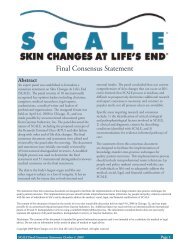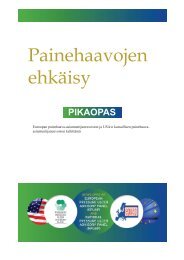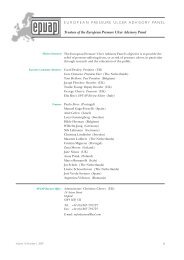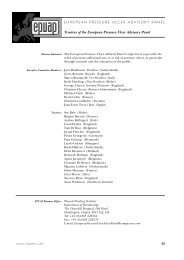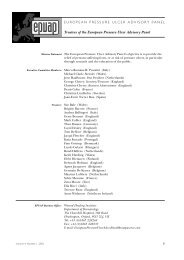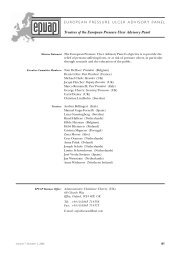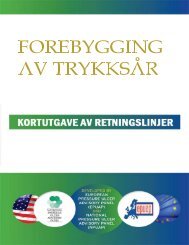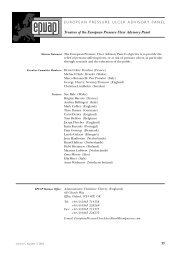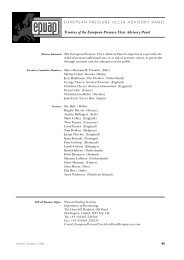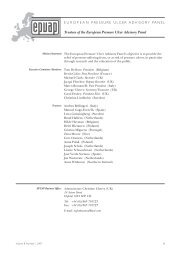Review 6.2 - European Pressure Ulcer Advisory Panel
Review 6.2 - European Pressure Ulcer Advisory Panel
Review 6.2 - European Pressure Ulcer Advisory Panel
Create successful ePaper yourself
Turn your PDF publications into a flip-book with our unique Google optimized e-Paper software.
ABSTRACTS FROM THE 2ND WUWHS MEETING<br />
Results: With regard to the demography of those two groups<br />
the same average age (82–84 years) and share of sex (74–<br />
82% female) were established. Concerning the risk of PU<br />
the two samples showed the same average Braden score<br />
(17.39–17.88) and a similar share of risk patients (64.7–<br />
65%). Hardly any differences were discovered in individual<br />
Braden items. The prevalence (when referring to the risk<br />
patients) was 38.3% in the Netherlands and 16.8% in Germany.<br />
Considerable correlation was found between PU<br />
prevalence and the residents’ age.<br />
Summary: The residents of both samples bear resemblance<br />
concerning the individual risk factors (such as age and<br />
Braden score). Additionally, the share of risk patients is<br />
equal in both study populations. Therefore, it is worthy of<br />
note that the prevalence of PU among nursing home residents<br />
in the Netherlands is different from the one in Germany.<br />
Further comparisons of nursing prevention interventions<br />
and supply quality will have to be drawn in future.<br />
<strong>Pressure</strong> <strong>Ulcer</strong> Prevalence: Using <strong>European</strong><br />
Methodology in the Irish Health Care Setting<br />
J. O’Brien, Z. Moore<br />
Background: <strong>Pressure</strong> ulcers are common, however, in Ireland<br />
there are no national prevalence figures available and<br />
no national guidelines exist for pressure ulcer prevention<br />
and management.<br />
Aims: 1. To gain insight into the use of the EPUAP pressure<br />
ulcer minimum data set 2. To establish pressure ulcer prevalence<br />
and risk status of the population in an acute hospital<br />
setting. 3. To identify the number and severity of pressure<br />
ulcers and prevention strategies in use.<br />
Methods: A survey was conducted using the EPUAP pressure<br />
ulcer minimum data set. Permission to conduct the study<br />
was granted from the Director of Nursing Services and ethical<br />
principles were adhered to. The study site was chosen<br />
using random sampling and all patients were assessed (n =<br />
519). Data analysis was carried out utilising SPSS version 11<br />
Results: <strong>Pressure</strong> ulcer prevalence was 15%. Most patients<br />
were in the acute care/high dependency care setting (63%)<br />
and 20% were at risk of pressure ulcer development ranging<br />
from low-high (Braden Scale). 78 pressure ulcers were<br />
identified and 57(73%) were grade 1 or2 damage (EPUAP<br />
grading). A range of prevention measures was used, the<br />
appropriateness of these varied among the risk groups.<br />
Discussion and Conclusion: This study provides a clearer understanding<br />
of the scale, nature and severity of the problem<br />
of pressure ulceration. Based on this information plans<br />
can be drawn regarding appropriate resource allocation and<br />
future research within the Irish population.<br />
<strong>Pressure</strong> <strong>Ulcer</strong>s: Recommendations Associated<br />
with Prevention<br />
P Brocker, F Mignolet, MJ Darmon, F Berthier, G. Daideri<br />
The objectives of this study were to carry out an audit for<br />
an inquiry into the prevalence of pressure ulcers in the<br />
whole of our University Hospital Centre and to develop the<br />
knowledge and practices of staff as well as the implementing<br />
the coordinated and appropriate use of the various existing<br />
medical devices and supports. The enquiry was carried<br />
out on a given day after the training of the investigators<br />
in the use of the Braden scale and the description of<br />
pressure ulcers according to the classification of Garches.<br />
It was completed by an audit of the resources. The results<br />
concern all the 1611 in-patients (784 men and 827 women).<br />
268 patients (16.6%) presented one or more pressure ulcers,<br />
but only 146 (9.1%) did so if the S1 stage (simple redness)<br />
was excluded. The prevalence determined was 7.5%<br />
(n = 120) and 3.7% (n = 60) if S1 was excluded. The most<br />
significant prevalence was found among the highest age<br />
ranges (35.6% for those over 85 years), and 77.3% of the<br />
total number of pressure ulcers was found among the population<br />
over 65 years. The prevalence of pressure ulcers by<br />
activity group was highest in the follow-up care and Rehabilitation,<br />
then in the Intensive Care Unit, with Long-term<br />
care, Medicine and Surgery following. The most frequent<br />
location of ulcers was the heel (46%), followed by the<br />
sacrum (26%). The S1 stage represented 70% of the pressure<br />
ulcers, S2 17% and S3 9%. This inquiry also revealed a<br />
failure in rehabilitation methods for the prevention of pressure<br />
ulcers due to lack of appropriate use of supports and<br />
the lack of information and training of the medical and<br />
nursing staff.<br />
Urban and Rural USA Nurses’ Knowledge of<br />
<strong>Pressure</strong> <strong>Ulcer</strong>s<br />
E.A. Ayello, Faan, K. Zulkowski, DNS, RN, CWS<br />
Introduction: <strong>Pressure</strong> ulcers continue to be an important<br />
issue for nursing home residents in the United States.<br />
Documentations and treatment of pressure ulcers are critical<br />
components in the provision of optimal care, in this<br />
population. In long term care (LTC) facilities, it is the staff<br />
nurses that must understand how to assess risk for pressure<br />
ulcers that have developed, and implement prevention/<br />
treatment programs. The knowledge level of nurses employed<br />
in long term care facilities has not been examined.<br />
Nurses in rural areas may have fewer opportunities for continuing<br />
education programmes than their urban counterparts.<br />
It is not known if there is a difference in pressure<br />
ulcer knowledge by geographic location.<br />
Methods: Nurses employed in LTC both urban and rural settings<br />
have been invited to participate in the study by completing<br />
a standardized pressure ulcer knowledge tool developed<br />
by Pieper and a demographic sheet developed by<br />
the authors.<br />
Results: Data is being analyzed using SPSS 11.5 statistical<br />
software. Data collection is in progress with over 700 surveys<br />
mailed. The presentation will give the results of both<br />
urban and rural nurses’ knowledge of pressure ulcer identification,<br />
risk and treatment using a standardized pressure<br />
ulcer tool developed by Pieper.<br />
Discussion: These data will help in planning future continuing<br />
education programmes for staff level nurses to enhance<br />
pressure ulcer care.<br />
Volume 6, Number 2, 2004 55



